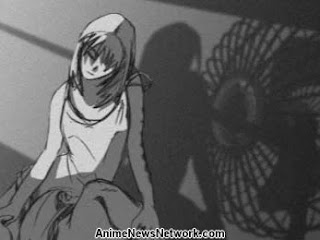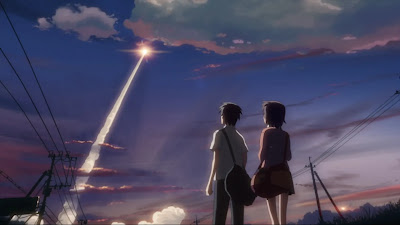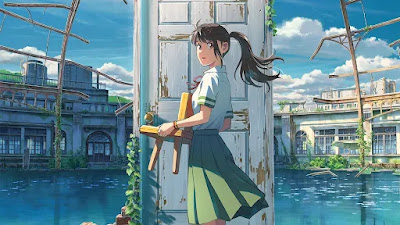
WRITER’S NOTE: The following reviews were originally posted on my Instagram page @be.kerian in late-2022 and throughout 2023.
Other Worlds (1999)
An effective and engaging black-and-white montage about a young man and woman who question whether their relationship will work or not. At just 90 seconds in length—and in spite its rough animation—animé director Makato Shinkai’s trademarks (from his editing style to character close ups) are on full display here. Plus, it makes great use of music from “Satie: Gymnopédie No. 1.”
She and Her Cat: Their Standing Points (1999)
That same year, Shinkai made this five-minute short (animated entirely in monochrome) about a pet cat and its female owner. A melancholic tale of romance and the change of seasons, told from the titular feline’s point of view, this detailed and captivating short is an immersive precursor to the career of one of our most original and daring voices in animé this century.
Voices of a Distant Star (2002)
Shinkai’s 25-minute short from 2002 is a genre-bending drama that combines a contemporary coming-of-age story with futuristic sci-fi. Centered on a long-distance relationship, including a teenage girl who takes part in an outer space mission, some of the character animation and designs are a little off-putting. But the concept is intriguing, as are themes of memory, missed opportunities, and time. This short helped set a template for the metaphysical and ambitious trademarks that would shape the young director’s career to come. It had never been seen by Western audiences until it debuted on the Blu-ray editions of Shinkai’s film, 5 Centimeters Per Second, in recent years.
Egao (2003)
This two-and-a-half music video for artist Hiromi Iwasaki’s song, Egao, centers on a girl and her pet hamster. (The artist must have been inspired by She and Her Cat.) Colorful, bright, and quietly emotional, this short also highlights themes of loneliness and companionship.
The Place Promised In Our Early Days (2004)
Set in an alternate post-war Japan, three teenage friends (Hiroki, Takuya, and Sayuri) plan to build an aircraft to someday visit a mysterious tower that connects directly to the sky. Years later, the tower ignites, and one of the friends (Sayuri) may be the only one to stop Earth from becoming an alternate dimension.
The directorial feature film debut of Shinkai, The Place Promised In Our Early Days contemplates dreams of the past, how things could have been, and what could be in an ever-changing world. It takes some cues from Shinkai’s previous short, Voices From a Distant Star (space stations, long-distance relationships), and visually predates a subsequent Shinkai project (breathtaking sky views, the passage of time, romanticism).
More importantly, this is a slow-burning drama about loneliness, as well as fear and hope. Featuring strong characters, a political undercurrent, violin and train track motifs, and a breathless climax, Place Promised is a daring sci-fi piece that blurs the line—at least for one character—between what is real and what is a dream, as well as persevering over time.
5 Centimeters Per Second (2007)
Told in three vignettes, this 63-minute feature follows two young adults as they grapple with love, memories, missed opportunities, and heartache. Using the speed of falling cherry blossoms as a visual metaphor (and where the film’s title comes from), the stories follow Takaki and Akari as they communicate through letters and text messages while navigating new cities, schools, relationships, work, and life. (Trains, rocket ships, snow, and even the passage of time itself, serve as other forms of visual poetry.) And yet, they struggle with sharing their true feelings for each other.
Filled with captivating scenery, atmospheric sound and editing, a beautiful score, and melancholic emotion, 5 Centimeters Per Second: A Chain of Short Stories About Their Distance is an amazing and moving work of art. Not to mention a high point in Makato Shinkai’s distinct career. It’s also a rare occasion where a series of shorts (or so it seems) collectively and brilliantly work in feature film format. And as a bittersweet coming-of-age drama, it’s a rare piece of animé that, according to its writer-director, doesn’t rely on elements of fantasy or science-fiction.
Children Who Chase Lost Voices (2011)
Shinkai sort of when against type with this story of a teenage girl who lives with her widowed and workaholic mother, but still coping with the recent loss of her father. The young Asuna spends most of her time alone, doing housework, and listening to her father’s crystal radio. One day, strange and inexplicable radio signals and messages lead her into a world where monsters roam and where the dead can be brought back to life—but at a terrible cost.
Children Who Chase Lost Voices From Deep Below starts out well enough, with compelling character arcs (including the mysterious Shen, stray cat Mimi, and substitute school teacher Mr. Morisaki, with his own hidden motives), breathtaking images of the stars and cosmos, familial relationships set against a mythological backdrop, and a heart-pounding score. It also displays strong themes of life, loss, death, grief, and resurrection. (The English dub is exceptional.)
The thing is, the film does so through a Gnostic—and often pessimistic—worldview, and through some violent and grotesque imagery. Especially during its second half, it also borrows heavily from previous Studio Ghibli entries like Castle in the Sky, Princess Mononoke, and Tales From Earthsea, making the film seem more like a knockoff than an original story. It goes to show that some story beats are not worth chasing more than once.
The Garden of Words (2013)
A young high schooler strikes up a relationship with an older woman when he skips school one rainy day to do some sketching in the city garden. That’s the basic premise of Makoto Shinkai’s 45-minute drama, declared by some as one of the most beautifully animated films ever made. And it’s easy to see why.
The animation of nature, weather, and sketching is meticulous and fitting for the story’s visual poetry involving rain, loneliness, and mystery. The character arcs of aspiring shoemaker Takao and the not-quite-mature Yukimo are compelling and layered, as they represent two strangers in their own worlds but share feelings of loneliness and uncertainty. And Daisuke Kashiwa’s score is melancholic and introspective.
The thing is, none of those elements can make up for the fact that Takao is 15 and Yukimo is 27. While the story doesn’t feature anything graphic, some scenes (including a foot-measuring bit) are nevertheless problematic—a fact that, to be fair, is brought up by at least one brutally honest character. (The English dub, sadly, features a few harsh profanities, including one f-bomb.) Yes, the garden is lovely, but it’s better to walk in it with maturity over fleeting emotions.
Someone’s Gaze (2013)
Released the same year as The Garden of Words, this seven-minute short was part of the “Proud Future Theater” collection when it screened during that year’s festival circuit. A bittersweet portrait of parent-child relationships, Someone’s Gaze is a profound and moving story (set in the future?) about loneliness and companionship, centered on a young woman, her father, and their pet cat. One of Shinkai’s best.
Cross Road (2014)
A quick, 2-minute montage that could easily be adapted and expanded into a feature film, Cross Road follows a boy and girl whose lives intersect as they each prepare for their college entrance exams. The short predates 2016’s Your Name. as far as intercut storylines, but Cross Road is more about two people who want to get out of their hometowns and out into the world. Effectively set to Nagi Yanagi’s music track of the same name.
Your Name. (2016)
Makoto Shinkai's breakout feature is an impressionistic and challenging coming-of-age feature. Your Name. follows a teenage boy in Tokyo and a teenage girl in Itomori (a.k.a. Hida) who miraculously switch bodies at random, with a strange comet apparently at the center of it. Part of Your Name. consists of a series of montages (the prologue feels like a music video), as main characters Mitsuha and Taki learn about each other, lay down ground rules to protect their lifestyles (easier said than done), and ultimately look for each other, despite being separated in more ways than one.
State-of-the-art animé and an ambitious story of memory, time, fate, and human connection, have made this film a standout in recent years (including IMDb's "Top 250"). Shinkai reveals jaw-dropping plot twists halfway through, where the film is at its strongest. It also integrates real-life natural disasters from Japan's recent history (a trademark Shinkai would revisit for his next films). At the same time, Your Name. represents Eastern spirituality and philosophy, not to mention secular views regarding changing the past and the future. Even the writer-director reportedly considered the final film to be "incomplete [and] unbalanced."
Weathering With You (2019)
In this coming-of-age story, a teenage boy named Hodaka runs away to Tokyo (where it apparently rains all the time), finds work at a small magazine editing company, and meets and falls for a teenage girl named Hira, who has the miraculous ability to control the weather and bring sunshine. Talk about a fish out of water, or a stranger in a strange land, so to speak. Shinkai continues his ambitious filmmaking with sharp montage editing, deep themes (some centered around adolescent romance), and state-of-the-art production design.
Unlike his previous film, Weathering of You deals with more mature subject matter, including economic struggles, sexuality (i.e., some references to prostitution are present, as are other suggestive references and images), secrets, spirituality (New Age philosophy?), and scenes of drinking, smoking, and gunplay. J.D. Salinger's acclaimed and controversial novel, The Catcher in the Rye, even makes an appearance. So while the film is amazing to look at, its overall story shines a light on characters searching for meaning and purpose, but going about it in rebellious and/or illegal ways.
Suzume (2022)
Another ambitious and incredible animé feature from Shinkai, Suzume follows the titular high school teenager who discovers doors around Japan that bring forth destruction. Along the way, she meets a mysterious young man, named Souta, on his own quest to find the same doors, as well as a mischievous cat that curses the heroic Souta by turning him into a toy chair.
This latter element is one of many subversive choices throughout this surprising and gripping coming-of-age story, which opens with a bang and never lets go. (At least one later scene carries a genuine sense of vertigo.) Apparently set during the COVID-19 pandemic, Suzume is also a cross country road trip adventure about friendship, geographical history, connection (Shinkai's films feature characters interacting on, or habitually using, social media), sacrifice, and reconciliation. The attention-to-detail and personality in the animation is superb, and the score by Radwimps and Kazuma Jinnouchi is an emotional roller-coaster--fitting for such a genre-bending piece.
A few references to older Studio Ghibli films are peppered throughout, including the same track from the opening credits of Kiki's Delivery Service. Plus, the imagery of a little girl in a mysterious field, as well as forgotten communities in ruins (a reflection of real-life natural disasters that have occurred in Japan) and glimpses of a spiritual dimension, are poetic, powerful, and profound. A standout film released in North America in 2023.


















